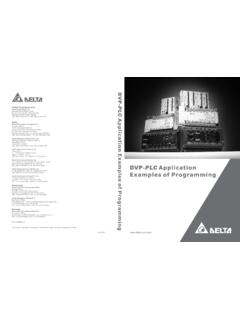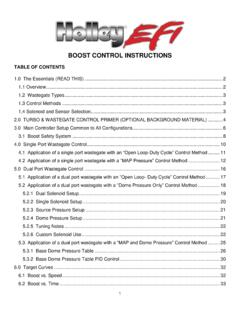Transcription of Module 08 Controller Designs: Compensators and PIDs
1 Design via Root-Locus IntroLead CompensatorPID Controllers DesignModule 08 Controller Designs: Compensators and PIDsAhmad F. TahaEE 3413: Analysis and Desgin of Control tahaMarch 31, 2016 Ahmad F. TahaModule 08 Controller Designs: Compensators and PIDs1 / 34 Design via Root-Locus IntroLead CompensatorPID Controllers DesignIntroductionReadings: , Ogata; , , Dorf & BishopIn Module 7, we learned to sketch the RL for any TFWe saw how poles change as a function of the gainK K was a Controller a constant controllerMany times,Kas a Controller is not enoughExample: system cannot be stabilized with a choice ofK-gainOr, settling time is still high, overshoot still badToday, we ll learn how to design more complicated controllersObjective:findGc(s) such that CLTF has desired properties suchas settling time, maximum overshoot.
2 Ahmad F. TahaModule 08 Controller Designs: Compensators and PIDs2 / 34 Design via Root-Locus IntroLead CompensatorPID Controllers DesignTypical RL Plots(a) Root-locus plot of a single-pole system; (b) root-locus plot of atwo-pole system; (c) root-locus plot of a three-pole system(a) Root-locus plot of a three-pole system; (b), (c), and (d)root-locus plots showing effects of addition of a zero to thethree-pole system. Ahmad F. TahaModule 08 Controller Designs: Compensators and PIDs3 / 34 Design via Root-Locus IntroLead CompensatorPID Controllers DesignEffects of Adding Poles and Zeros on RLAdding polespullsthe RL to theright Systems become less stable , settling is slowerAdding zerospullsthe RL to theleft Systems become more stable (this is tricky), settling is fasterQuestion:Can we conclude that a compensator ( Controller )Gc(s)should always be a combination of zeros?
3 Since, you know, it makessystemmore stableand settling is faster?Not adding a zero amplifies thehighfrequency noiseSo, we can t add a zero alone ( ,Gc(s) =s+z), and we can tadd a pole alone either (Gc(s) =1s+p). Solution?Solution Add a compensator of this form:Gc(s) =Ks+zs+p Objective: find K, z, p given certain desired properties Ahmad F. TahaModule 08 Controller Designs: Compensators and PIDs4 / 34 Design via Root-Locus IntroLead CompensatorPID Controllers DesignTwo Controller Choices: Lead and Lag CompensatorsGc(s) =Ks+zs+p Objective: find K, z, p given certain desired propertiesForGc(s) above,K,z,pare allreal +vevalues to be found 2 combinations: (a)lead Controller ; (b)lag Controller : Ahmad F.
4 TahaModule 08 Controller Designs: Compensators and PIDs5 / 34 Design via Root-Locus IntroLead CompensatorPID Controllers DesignLead and Lag CompensatorsLead compensatorprovides a +ve angle contribution:Gldc(s) =Ks+zs+p Gldc(s) = (s+z) (s+p) = z p= lead>0 Speeds up transients by lowering rise time & decreasing overshootsLag compensatorprovides a -ve angle contribution:Gldc(s) =Ks+zs+p Gldc(s) = (s+z) (s+p) = z p= lag<0 Improves the steady-state accuracy of the system for tracking inputsWhat ifp=z? That s a constant gain (pole & zero cancel out) Ahmad F. TahaModule 08 Controller Designs: Compensators and PIDs6 / 34 Design via Root-Locus IntroLead CompensatorPID Controllers DesignLead Compensator ExampleInitially, the above system has = and n= 2 Obj:designGldc(s) =C(s) =Ks+zs+p, such that d= , nd= 4 Can we do that via gainK?
5 No, see the RL below forC(s) =KHence, we canneverreachsdvia a constant gain, need compensatorsd= d nd 1 2d nd= 2 j2 3 Ahmad F. TahaModule 08 Controller Designs: Compensators and PIDs7 / 34 Design via Root-Locus IntroLead CompensatorPID Controllers DesignLead Compensator Example (Cont d)Objective:designGldc(s) =Ks+zs+p, such that d= , nd= 4To findK,z,p, follow this algorithm:0. Findsdfors2d+ 2 d ndsd+ 2nd= 0,sd= 2 +j2 31. Findangle of deficiency , as follows: = G(sd) = G( 2 +j2 3) = 210 deg = 180 ( ) = 30 deg2. Connectsdto the origin OK3. Draw a horizontal line to the left fromsd OK4. Find the bisector of the above two lines OK5. Draw 2 lines that make angles /2 & /2 with the bisector OK6.
6 Their intersections with the real lines are pand z OK Ahmad F. TahaModule 08 Controller Designs: Compensators and PIDs8 / 34 Design via Root-Locus IntroLead CompensatorPID Controllers DesignLead Compensator Example FindingKWe now know thatz= ,p= Gldc(s) =C(s) =Ks+ + know that all points on the RL satisfy1 +KG(s)Gldc(s) = 0 1 =|KG(s)Gldc(s)|We knowfor surethatsdbelongs to the RL, so solve forK:|4 Ksd+ (sd+ 2)(sd+ )|= 1 K= Gldc(s) =C(s) = + + plot: Ahmad F. TahaModule 08 Controller Designs: Compensators and PIDs9 / 34 Design via Root-Locus IntroLead CompensatorPID Controllers DesignStep Response: Old vs. New ResponseCompensated system reaches SS faster (shorter rise, settling times),although it has a higher Mp.
7 That said, we designed the compensatoraccording to the design specs. Design specs weren t so smart, perhaps. Ahmad F. TahaModule 08 Controller Designs: Compensators and PIDs10 / 34 Design via Root-Locus IntroLead CompensatorPID Controllers DesignLead Compensator Example 2 GivenG(s) =10s(s+ 1), findGldc(s) such that the CLTF has d= and nd= 3 Figures: (a) uncompensated control system (b) uncompensatedroot-locus plot Ahmad F. TahaModule 08 Controller Designs: Compensators and PIDs11 / 34 Design via Root-Locus IntroLead CompensatorPID Controllers DesignLead Compensator Example 2 (Cont d)GivenG(s) =10s(s+ 1), findGldc(s) such that the CLTF has d= and nd= 3 Figures: (a) compensated system, (b) desired closed-loop polelocation Ahmad F.
8 TahaModule 08 Controller Designs: Compensators and PIDs12 / 34 Design via Root-Locus IntroLead CompensatorPID Controllers DesignLead Compensator Example 2 (Cont d)Objective:designGldc(s) =Ks+zs+p, such that d= , nd= 30. Findsdfors2d+ 2 d ndsd+ 2nd= 0,sd= Findangle of deficiency , as follows: = G(sd) = G( + ) = 138 deg = 180 (138) = 318 42 deg2. Connectsdto the origin OK3. Draw a horizontal line to the left fromsd OK4. Find the bisector of the above two lines OK5. Draw 2 lines that make angles /2 & /2 with the bisector OK6. Their intersections with the real lines are pand z OK Ahmad F. TahaModule 08 Controller Designs: Compensators and PIDs13 / 34 Design via Root-Locus IntroLead CompensatorPID Controllers DesignCompensated System, Example 2 Unit-step response and RL plot for the compensated system: Ahmad F.
9 TahaModule 08 Controller Designs: Compensators and PIDs14 / 34 Design via Root-Locus IntroLead CompensatorPID Controllers DesignLag, Lead-Lag CompensatorsNow that we understand lead Compensators , we can discuss lag andlead-lag compensatorsRecall that lead Compensators : improve transient response andstabilityBut they do not typically reduce SSELag compensatorsGlgc(s): reduce SSE, so sometimes we wantsmaller SSE rather than shorter rise and settling time as in a leadcompensatorOptimal solution:lead-lag (LL) compensator Gllc(s) =Gldc(s)Glgc(s)LL Compensators provides the benefits of both lead and lagcompensators Ahmad F. TahaModule 08 Controller Designs: Compensators and PIDs15 / 34 Design via Root-Locus IntroLead CompensatorPID Controllers DesignLead-Lag CompensatorsUnfortunately, we don t have time to cover LL compensator designDesign procedure is simple, please read more about it from yourtextbooksBut we ll show a figure that illustrates the difference in performance:Left figure (step response), right figure (ramp response) Ahmad F.
10 TahaModule 08 Controller Designs: Compensators and PIDs16 / 34 Design via Root-Locus IntroLead CompensatorPID Controllers DesignPID Control Definitions and BasicsProportionalIntegralDerivative Controller PID controlWithout a doubt the most widely used controllers in industry todayBread and butter of control, 90% of control loops use PID controlProportional:Gc(s) =K, Integration:Gc(s) =1Ts, Derivative:Gc(s) =KsCan have combinations of the above controllers: P,I,D,PI,PD,ID,PIDM ajor objectives for designingGc(s):1 Stability the most important objective: CLTF is stable2 Steady-state error (SSE) minimize this as much as we could3 Time-specs Mp,tr,ts,.. Ahmad F. TahaModule 08 Controller Designs: Compensators and PIDs17 / 34 Design via Root-Locus IntroLead CompensatorPID Controllers DesignPID Controller DeviceYou can either use some tuning rules (which we will learn about duringthis Module ), or use an auto-tune function that figures out theparameters to a PID Controller .







